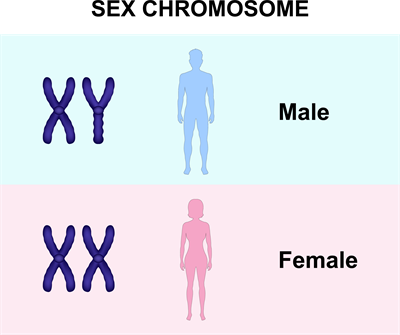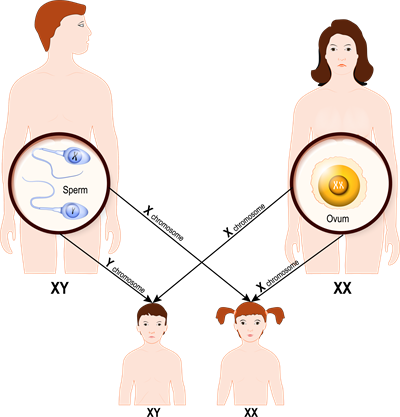PDF chapter test TRY NOW
Chromosomes are thread-like structures present in the nucleus of cells of the human body.
All humans have \(23\) pairs of chromosomes in the nuclei of the normal body cell. The chromosomes help in the sex determination of the child.
\(1\) pair (\(X\) and \(Y\) chromosome) in these \(23\) pairs of chromosomes are called the sex chromosomes. The two chromosomes \(X\) and \(Y\), determine the sex of the young one or the offspring. The chromosomes are present inside the fertilised egg or the zygote.

The female has two \(X\) chromosomes, while the male has one \(X\) and one \(Y\) chromosome. Gamete (egg and sperm) are reproductive cells that contain only a single set of chromosomes. Thus, the gamete has only one of the two sex chromosomes present in the normal body cells.
In females, all the gametes or the egg cells contain the \(X\) chromosome. In males, half of the sperms have \(X\) chromosome, and half of the sperms have \(Y\) chromosome. The sex of the baby is decided when the sperm fertilise an egg.
If the sperm that contains a \(Y\) chromosome fertilises the egg, which contains the \(X\) chromosome (always), the zygote has \(XY\) combination of sex chromosomes and develops into a male.
On the contrary, if the sperm that contains an \(X\) chromosome fertilises the egg, which contains \(X\) chromosome, the zygote has \(XX\) combination of sex chromosomes and develops into a female.
Thus it is evident that the sperm of the male determines the sex of the child. The sex of the baby depends upon the chromosomes of the father and not the mother.
In females, all the gametes or the egg cells contain the \(X\) chromosome. In males, half of the sperms have \(X\) chromosome, and half of the sperms have \(Y\) chromosome. The sex of the baby is decided when the sperm fertilise an egg.
If the sperm that contains a \(Y\) chromosome fertilises the egg, which contains the \(X\) chromosome (always), the zygote has \(XY\) combination of sex chromosomes and develops into a male.
On the contrary, if the sperm that contains an \(X\) chromosome fertilises the egg, which contains \(X\) chromosome, the zygote has \(XX\) combination of sex chromosomes and develops into a female.
Thus it is evident that the sperm of the male determines the sex of the child. The sex of the baby depends upon the chromosomes of the father and not the mother.

Sex determination of children
Pregnancy in adolescence:
The legal age for marriage is \(18\) years for girls and \(21\) years for boys. The legal age for girls is fixed as \(18\) years as early motherhood cause problems in both mothers and the baby.
- Problems that arise due to adolescent marriage and pregnancy.
- Teenagers are not prepared physically or mentally for motherhood.
- Early marriage and pregnancy cause health problems in both the mother and the child.
- Extreme suffering and mental agony as the teenager are not ready for the responsibilities of motherhood.
- Reduction in higher education and employment opportunities for young women.
